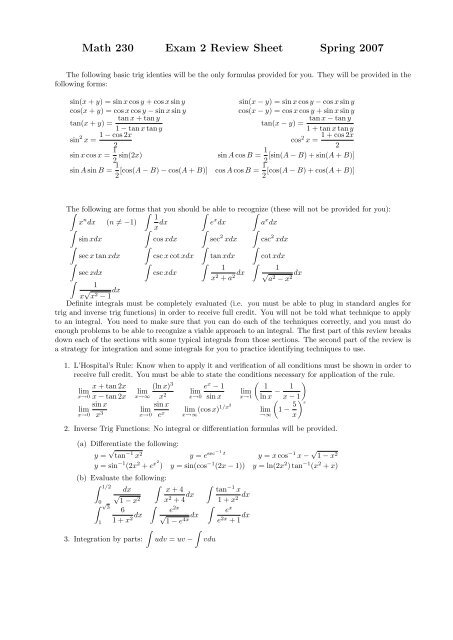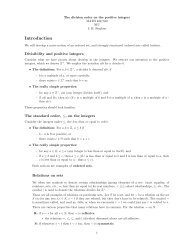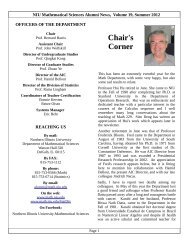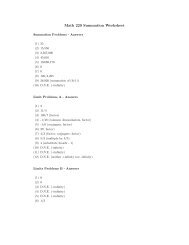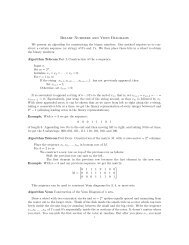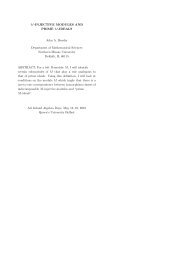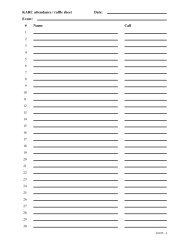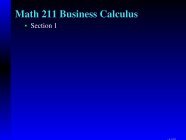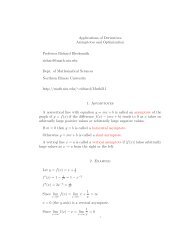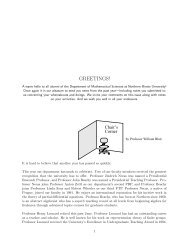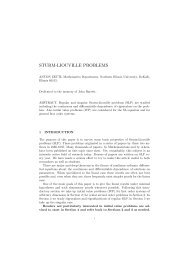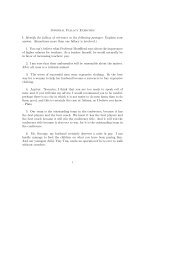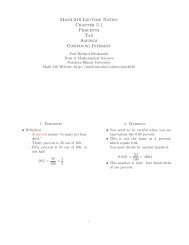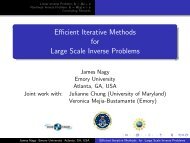Math 230 Exam 2 Review Sheet Spring 2007
Math 230 Exam 2 Review Sheet Spring 2007
Math 230 Exam 2 Review Sheet Spring 2007
You also want an ePaper? Increase the reach of your titles
YUMPU automatically turns print PDFs into web optimized ePapers that Google loves.
<strong>Math</strong> <strong>230</strong> <strong>Exam</strong> 2 <strong>Review</strong> <strong>Sheet</strong> <strong>Spring</strong> <strong>2007</strong><br />
The following basic trig identies will be the only formulas provided for you. They will be provided in the<br />
following forms:<br />
sin(x + y) = sin x cos y + cos x sin y<br />
cos(x + y) = cos x cos y − sin x sin y<br />
tan x + tan y<br />
tan(x + y) =<br />
1 − tan x tan y<br />
sin 2 1 − cos 2x<br />
x =<br />
2<br />
sin x cos x = 1 2 sin(2x)<br />
sin A sin B = 1 [cos(A − B) − cos(A + B)]<br />
2 cos<br />
sin(x − y) = sin x cos y − cos x sin y<br />
cos(x − y) = cos x cos y + sin x sin y<br />
tan x − tan y<br />
tan(x − y) =<br />
1 + tan x tan y<br />
cos 2 1 + cos 2x<br />
x =<br />
2<br />
sin A cos B = 1 [sin(A − B) + sin(A + B)]<br />
2 A cos B = 1 [cos(A − B) + cos(A + B)]<br />
2<br />
The ∫ following are forms∫that you should ∫be able to recognize ∫ (these will not be provided for you):<br />
1<br />
x n dx (n ≠ −1)<br />
x dx e x dx a x dx<br />
∫<br />
∫<br />
∫<br />
∫<br />
sin xdx<br />
cos xdx sec 2 xdx csc 2 xdx<br />
∫<br />
∫<br />
∫<br />
∫<br />
sec x tan xdx csc x cot xdx tan xdx cot xdx<br />
∫<br />
∫<br />
∫<br />
∫<br />
1<br />
sec xdx<br />
csc xdx<br />
x 2 + a 2 dx 1<br />
√<br />
∫<br />
a2 − x dx 2<br />
1<br />
x √ x 2 − 1 dx<br />
Definite integrals must be completely evaluated (i.e. you must be able to plug in standard angles for<br />
trig and inverse trig functions) in order to receive full credit. You will not be told what technique to apply<br />
to an integral. You need to make sure that you can do each of the techniques correctly, and you must do<br />
enough problems to be able to recognize a viable approach to an integral. The first part of this review breaks<br />
down each of the sections with some typical integrals from those sections. The second part of the review is<br />
a strategy for integration and some integrals for you to practice identifying techniques to use.<br />
1. L’Hospital’s Rule: Know when to apply it and verification of all conditions must be shown in order to<br />
receive full credit. You must be able to state the conditions necessary for application of the rule.<br />
x + tan 2x (ln x) 3 e x (<br />
− 1<br />
1<br />
lim<br />
lim<br />
x→0 x − tan 2x x→∞ x 2 lim<br />
lim<br />
x→0 sin x x→1 ln x − 1 )<br />
x − 1<br />
lim<br />
x→0<br />
sin x<br />
x 3<br />
sin x<br />
lim<br />
x→0 e x<br />
lim (cos x)1/x2 lim<br />
x→∞<br />
→∞<br />
(1 − 5 x<br />
2. Inverse Trig Functions: No integral or differentiation formulas will be provided.<br />
(a) Differentiate the following:<br />
y = √ tan −1 x 2 y = e sec−1 t<br />
y = x cos −1 x − √ 1 − x 2<br />
y = sin −1 (2x 2 + e x2 ) y = sin(cos −1 (2x − 1)) y = ln(2x 2 ) tan −1 (x 2 + x)<br />
(b) Evaluate the following:<br />
∫ 1/2<br />
0<br />
∫ √ 3<br />
dx<br />
√<br />
1 − x<br />
2<br />
∫<br />
6<br />
1 1 + x 2 dx ∫<br />
3. Integration by parts:<br />
∫ x + 4<br />
x 2 + 4 dx<br />
e 2x<br />
√<br />
1 − e<br />
4x dx<br />
∫<br />
udv = uv −<br />
∫ tan −1 x<br />
1 + x 2 dx<br />
∫<br />
e x<br />
e 2x + 1 dx<br />
vdu<br />
) x
∫<br />
∫<br />
e −x (x 3 + 7x + 2)dx<br />
x 3 tan −1 xdx<br />
∫<br />
∫<br />
x cos xdx<br />
(ln x) 2 dx<br />
∫<br />
x5 x dx<br />
∫<br />
x 5 e x2 dx<br />
4. Trigonometric Integrals:<br />
∫<br />
(a) the form sin m x cos n xdx<br />
i. cos x power odd - save one cos x factor<br />
ii. sin x power odd - save one sin x factor<br />
iii. both cos x and sin x have odd powers - can save your favorite<br />
iv. both cos x and sin x have even powers - use the half-angle identites to convert to an easier<br />
form<br />
∫<br />
(b) the form tan m x sec n xdx<br />
i. sec x power even - save one sec 2 x factor<br />
ii. tan x power is odd - save one sec x tan x factor<br />
∫<br />
∫<br />
∫<br />
(c) the forms sin(mx) cos(nx)dx, sin(mx) sin(nx)dx, and cos(mx) cos(nx)dx require the appropriate<br />
conversions using formulas for products of trig functions.<br />
∫ π/2<br />
∫<br />
∫ π/4<br />
cos 4 xdx tan 4 xdx<br />
sec 6 xdx<br />
∫0<br />
∫ 0<br />
sec<br />
sin 6 x cos 3 2 ∫<br />
x<br />
xdx<br />
cot x dx sin(5x) sin(2x)dx<br />
5. Trig Substitution: can be used when √ a 2 − x 2 , √ a 2 + x 2 , √ x 2 − a 2 show up in an integral.<br />
∫ 3<br />
∫<br />
dx<br />
1 √ ∫<br />
dx<br />
√ x2 + 1dx √<br />
0 9 + x<br />
2<br />
∫<br />
∫ 0<br />
x2 − 6x + 13<br />
dx<br />
√ e t√ ∫ 3<br />
9 − e 2t dt x √ 9 − x 2 dx<br />
9x2 + 6x − 8<br />
0<br />
6. Partial Fractions: you will be asked to express a complicated rational function in partial fraction<br />
terms without solving for the constants or evaluating the integral. You will also be asked to solve one<br />
completely. Remember that it is only applicable when the degree of the denominator is larger than<br />
the degree of the numerator and that the denominator must be completely factored into irreducible<br />
quadratics and linear factors.<br />
(a) Express the following in a partial fraction decomposition without solving for the terms.<br />
i.<br />
ii.<br />
4x 2 − 2x + 9<br />
x 3 (x + 1) 2 (x − 1)(x 2 − 4) 2 (x 2 + 2)(x 2 + 3) 3<br />
6x 2 − x + 13<br />
x 2 (x − 1)(x + 3) 2 (x 2 + 7)(x 2 − 7) 2 (x 2 + x + 1) 3<br />
(b) Solve the following completely<br />
∫ x 3 + x 2 ∫<br />
− 12x + 1 x 3 − 2x 2 + x + 1<br />
x 2 dx<br />
+ x − 12<br />
x 4 + 5x 2 dx<br />
∫ + 4<br />
x 2 ∫<br />
+ 1<br />
1<br />
x 2 − x dx<br />
Strategy for integration:<br />
1. Simplify the Integrand if Possible:<br />
(a) distribution of terms<br />
(b) splitting of fractions<br />
0<br />
∫<br />
1<br />
x 3 + x 2 − 2x dx<br />
x 2 − x + 6<br />
x 3 + 3x dx ∫ x 3 + x 2 + 2x + 1<br />
(x 2 + 1)(x 2 + 2) dx
(c) trig identities<br />
2. Look for an obvious substitution. This is why you need to KNOW the list of integrals at the beginning<br />
of this sheet.<br />
3. Classify the integrand according to its form<br />
(a) Powers of trig functions? – trigonometric integrals good place to start<br />
(b) Rational function? – partial fractions a good place to start<br />
(c) Product of two functions? – parts a good place to start<br />
(d) Radicals? – perhaps a trig sub will get you there<br />
4. Still no answer? Try again.<br />
(a) Did you miss a substitution?<br />
(b) Will parts work? Although it is usually used on products of functions, it can be used on single<br />
functions.<br />
(c) Can you manipulate the integrand? i.e. rationalize the denominator, trig identities, etc.<br />
(d) Have you seen the problem before? Can you relate it to a previous homework problem or example<br />
from class?<br />
(e) Sometimes more than one method is required. You might need to do substitutions within parts<br />
or some other combination of techniques.<br />
Integrate ∫ the following by any method or combination of methods.<br />
e x<br />
∫<br />
1.<br />
1 + e x dx 2. e x<br />
∫<br />
1 + e 2x dx 3. e √x dx<br />
∫<br />
∫<br />
∫<br />
1<br />
4.<br />
1 + e 2x dx 5. t 3 e −t2 dt 6. sin(ln x)dx<br />
∫<br />
∫<br />
∫<br />
sin(2x)<br />
7.<br />
1 + sin 2 x dx 8. sin 3 x ln(cos x)dx 9. (sin x) e (cos x) 3 dx<br />
∫<br />
∫<br />
∫<br />
10. sec 3 x tan 3 xdx 11. (ln x) 2 ln x<br />
dx 12.<br />
x √ 1 + ln x dx<br />
∫<br />
13. tan −1 ( √ ∫ sin −1 ∫<br />
x<br />
1<br />
t)dt 14.<br />
x 2 dx 15.<br />
∫<br />
∫<br />
∫ sec x + tan x dx<br />
1<br />
tan −1<br />
16. sin(3θ) cos(θ)dθ 17.<br />
1 − sin x dx 18. (e x )<br />
e x dx<br />
∫<br />
x 2<br />
∫ sin 2<br />
19.<br />
(1 + x 2 ) 2 dx 20. x − cos 2 ∫<br />
x<br />
√3<br />
dx 21. − x2 dx<br />
∫<br />
∫ √ cos x<br />
∫<br />
x<br />
3 − x<br />
22. √ dx 23. 2<br />
1<br />
dx 24.<br />
3 − x<br />
2 x<br />
(x 2 − 4x + 4)(x 2 − 4x + 5) dx<br />
∫<br />
∫<br />
∫<br />
1<br />
25.<br />
(a sin x + b cos x) 2 dx 26. 1<br />
π/2<br />
a 2 sin 2 x + b 2 cos 2 x dx 27. sin x<br />
0 1 + cos x + sin x dx<br />
(a ≠<br />
∫<br />
0) (ab<br />
∫<br />
≠ 0)<br />
1<br />
28. √<br />
x2 + x dx<br />
29. x 4 ∫<br />
+ 1<br />
x(x 2 + 1) 2 dx 30. 4x 5 − 1<br />
∫<br />
∫<br />
(x 5 + x + 1) 2 dx<br />
1<br />
31.<br />
x − √ x dx<br />
32. sin x sin 2x sin 3xdx
<strong>Math</strong> <strong>230</strong> <strong>Exam</strong> 2 <strong>Spring</strong> 2002<br />
1. Find the derivatives of the following functions:<br />
(a) y = ln(2x) tan −1 (x 2 )<br />
(b) y = sin(cos −1 (2x − 1))<br />
2. Find the following limits:<br />
(a) lim<br />
x→0<br />
1 − cos 2x<br />
x sin s<br />
(b)<br />
lim<br />
x→∞ (1 − 5 x )x<br />
3. Evaluate the following integrals:<br />
∫<br />
(a) (4 − x)e −3x dx<br />
∫<br />
(b) x 2 tan −1 xdx<br />
(c)<br />
∫<br />
e<br />
cos −1 x<br />
√<br />
1 − x<br />
2 dx<br />
(d)<br />
(e)<br />
(f)<br />
(g)<br />
∫ 1<br />
∫<br />
∫<br />
0<br />
x 2<br />
√<br />
4 − x<br />
2 dx<br />
sin 3 x cos 4 xdx<br />
dx<br />
x 4√ x 2 − 1<br />
∫<br />
dx<br />
x(x 2 + 1)<br />
4. Let a curve C be defined by y = sin −1 (x 2 ), 0 ≤ x ≤ 1. Set up an integral for the length of this curve.<br />
Do not evaluate it.


